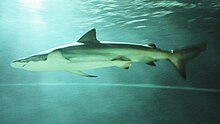Bronze whaler shark
| Copper shark | |
|---|---|
 |
|
| Scientific classification | |
| Kingdom: | Animalia |
| Phylum: | Chordata |
| Class: | Chondrichthyes |
| Subclass: | Elasmobranchii |
| Superorder: | Selachimorpha |
| Order: | Carcharhiniformes |
| Family: | Carcharhinidae |
| Genus: | Carcharhinus |
| Species: | C. brachyurus |
| Binomial name | |
|
Carcharhinus brachyurus (Günther, 1870) |
|
 |
|
| Confirmed (dark blue) and suspected (light blue) range of the copper shark | |
| Synonyms | |
|
Carcharhinus acarenatus Moreno & Hoyos, 1983 *ambiguous synonym |
|
Carcharhinus acarenatus Moreno & Hoyos, 1983
Carcharhinus improvisus Smith, 1952
Carcharhinus remotoides Deng, Xiong & Zhan, 1981
Carcharhinus rochensis Abella, 1972
Carcharias brachyurus Günther, 1870
Carcharias lamiella Jordan & Gilbert, 1882
Carcharias remotus Duméril, 1865
Eulamia ahenea Stead, 1938
Galeolamna greyi*Owen, 1853
*ambiguous synonym
The copper shark, bronze whaler, or narrowtooth shark (Carcharhinus brachyurus) is a species of requiem shark, family Carcharhinidae, and the only member of its genus found mostly at temperate latitudes. It is distributed in a number of separate populations in the northeastern and southwestern Atlantic, off southern Africa, in the northwestern and eastern Pacific, and around Australia and New Zealand, with scattered reports from equatorial regions. This species can be found from brackish rivers and estuaries, to shallow bays and harbors, to offshore waters 100 m (330 ft) deep or more. Females are found apart from males for most of the year, and conduct seasonal migrations. A large species reaching 3.3 m (11 ft) long, the copper shark is difficult to distinguish from other large requiem sharks. It is characterized by its narrow, hook-shaped upper teeth, lack of a prominent ridge between the dorsal fins, and plain bronze coloration.
Feeding mainly on cephalopods, bony fishes, and other cartilaginous fishes, the copper shark is a fast-swimming predator that has been known to hunt in large groups, utilizing their numbers to their advantage; however for most of the time they remain solitary. Off South Africa, this species associates closely with the annual sardine run, involving millions of southern African pilchard (Sardinops sagax). Like other requiem sharks, it is viviparous, with the developing embryos mainly nourished through a placental connection formed from the depleted yolk sac. Females bear litters of 7 to 24 pups every other year in coastal nursery areas, after a gestation period of 12 or perhaps as long as 21 months. It is extremely slow-growing, with males and females not reaching maturity until 13–19 and 19–20 years of age respectively.
...
Wikipedia

